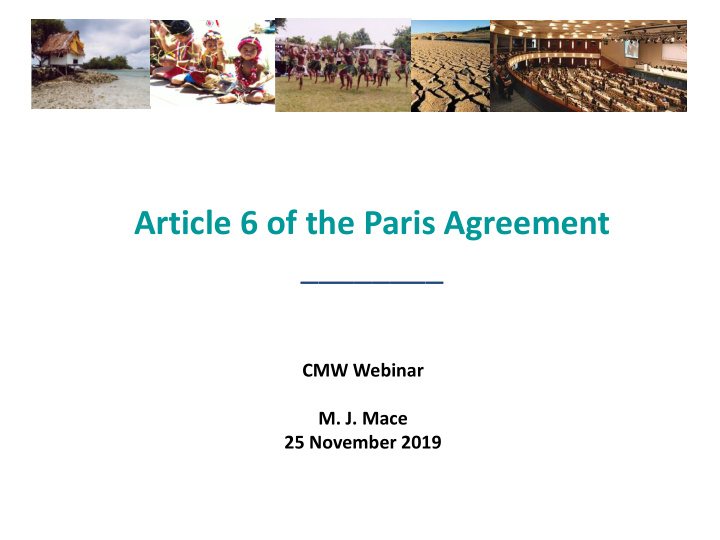



Article 6 of the Paris Agreement ________ CMW Webinar M. J. Mace 25 November 2019
Context? • Under Paris Agreement , all Parties agree to pursue temperature limitation goal of 1.5 ° C • IPCC 1.5 ° C Special Report – greater temperature risks greater impacts, tipping points; consistency with this goal requires achievement of net zero by around 2050 • UNEP Gap Report – NDCs not consistent with Paris goals, far greater ambition needed between now and 2030 • Offsetting will not get us to net zero • Article 6.4 (d) – the mechanism “shall aim” to deliver an overall mitigation in global emissions • All Parties now have NDCs – offsets do not deliver global mitigation
AOSIS Priorities 1. Ensure environmental integrity – do not undermine existing NDCs – Common international accounting framework, centralised oversight – Limit Article 6 activities to inside scope of NDCs – Corresponding adjustments for both 6.2 and 6.4; no temporal exclusions from corresponding adjustments – No carryover of units from KP, no banking – protect NDC ambition and create space for new projects – CORSIA – corresponding adjustments required 2. Use Article 6 to deliver more mitigation and adaptation ambition – all available tools are needed to deliver PA goals – IPCC Reports - next 10 years are key for 1.5 C limit – pure offsetting will not help; impacts accelerating • OMGE % cancellation/discount on 6.4 and 6.2, paired with adjustment in Host Party – deliver net global emission reductions through A6 design • Share of proceeds for adaptation (Art. 6.6) – SOP % on 6.4 and 6.2
AOSIS Submission on Arts 6.2 and 6.4 of the Paris Agreement 27 April 2017
Overall Mitigation in Global Emissions • Why?: Art 6.4(d): mechanism “shall aim to deliver” an OMGE; Art. 6.2 for balance – process whereby 1 tonne of reductions in one country continues to enable 1 tonne of emissions in another country will not take us toward net zero – generating OMGE justifies UNFCCC involvement, enhances credibility of offsets, acceptability of use • Process - a fixed % of offset credits are cancelled at issuance under 6.4 and 6.2; accounting rules ensure that host country applies a corresponding adjustment for all offset credits issued; buyer applies adjustment for number of credits acquired • Why use % cancellation/discounting? - easy to apply, no differentiation among project types or Parties needed; can point to a quantum delivered • Price and volume effects – price increases, volume transacted decreases • Project owners – higher profits, as increase in credit prices outweighs effect of receiving fewer credits; increases internal rate of return for projects • Host countries – benefit as more projects take place; higher prices enhance feasibility of more costly mitigation options • Buyers of credits – pay more for credits, but typically still pay less than domestic abatement; maximum price increase is limited (e.g., 10%, max price increase 11%; OMGE of 20%, max price increase of 25%) • Non-host countries - benefit from additional abatement
Lessons learned from Kyoto Protocol • Efficiency of flexible mechanisms alone did not produce more ambition – CDM – offsetting only; did not produce net global reductions; questions raised about additionality – Joint Implementation – offsetting only; hot air undermined delivery of quantified targets – International Emissions Trading – offsetting only; transfers of hot air undermined targets • Resulting credibility challenges, low prices
Recommend
More recommend